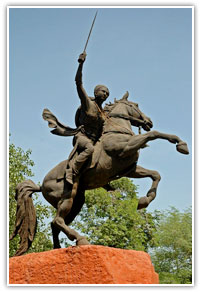|
History of Jhansi
Jhansi was a stronghold of the Chandela kings but
lost its importance after the eclipse of the
dynasty in the 12 century. It rose to prominence
again in the 17th century under King Bir Singh
Judeo of Orchha. Nearly four centuries ago, Bir
Singh had a visitor, the ruler of Jaitpur. To
impress his fellow Raja, Bir Singh asked him if he
could see the new palace he had built atop a hill
on the dusty heat-hazed horizon. The raja of
Jaitpur shaded his eyes, squinted and then
admitted that he could see it but only 'Jhainsi'
or indistinctively. That is what Bir Singh decided
to call it and from Jhainsi it became Jhansi.
Jhansi remained a small village until it was taken
in 1742 by Naru Shankar, a Maratha. He built the
Shankar Fort. In the 18th century, Jhansi was a
power to reckon within the region. Under the
pretext that the Maharaja of Jhansi had died
laving no heir, the British intervened in the
affairs of Jhansi. The East India |
 |
|
|
Company
acquired control in 1803 and took over the state of
Jhansi and pensioned off the Maharani. The fort was
seized in 1857 and most of the occupants slaughtered.
The Rani, who had a $6,000 pension from the British
still had a grievance with them because under this new
system she was not allowed to adopt an heir. When the
Indian Mutiny burst into flames, the Maharani was in the
forefront of the rebellion. The British Resident posted
at Jhansi was wiped off. She joined the rebels and led
her forces against the British and sacrificed her life
to the cause of India’s independence. She was killed on
18th June 1858 in a battle at Kotah-ki-Sarai dressed
like a man, holding her sword two-handed and holding the
reins of her horse in her teeth. Since then she is
adored as a great heroine for India’s struggle for
independence. Five thousand people died in the siege and
fighting around Jhansi.
Tourist
Attractions in Jhansi
The main tourist attractions in Jhansi are the Jhansi
fort, Jhansi Museum, Rani Mahal and Chhatri of Gangadhar
Rao. The Jhansi fort was built by King Bir Singh Judeo
of Orchha in the 17th century on the top of a hill, as
an army stronghold. The Jhansi Fort offers excellent
views from its ramparts. The palace of Queen Laxmi Bai
or Rani Mahal is a fine piece of traditional
architecture, which has now been converted into a
museum. The chhatri or cenotaph of Gangadhar Rao, the
Rani Laxmi Bai's husband stands in a walled enclosure.
This cenotaph is centred around a pavilion and devoid of
frescoes.
More....
How to reach Jhansi
By Air:
The nearest airport is located in Gwalior, about 98 km.
from Jhansi.
By Rail:
Jhansi is well connected by an excellent railway network
with all other major cities. The nearest railway station
for Deogarh is Jakhalaun, about 13 km, which can be
reached by Jhansi-Babina passenger train.
By Road:
Jhansi is well connected with a good network of roads.
Jhansi is located on the National Highways 25 and 26. It
is also connected with all major cities like Orchha,
Datia, Khajuraho, Agra, Lucknow and Delhi. |